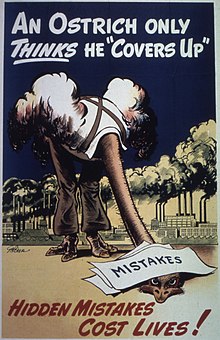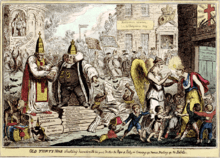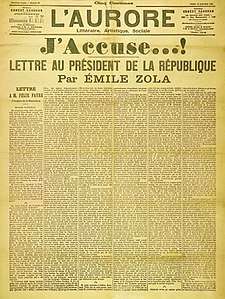Cover-up
A cover-up is an attempt, whether successful or not, to conceal evidence of wrongdoing, error, incompetence or other embarrassing information. In a passive cover-up, information is simply not provided; in an active cover-up, deception is used.
The expression is usually applied to people in positions of authority who abuse power to avoid or silence criticism or to deflect guilt of wrongdoing. Perpetrators of a cover-up (initiators or their allies) may be responsible for a misdeed, a breach of trust or duty, or a crime.
While the terms are often used interchangeably, cover-up involves withholding incriminatory evidence, while whitewash involves releasing misleading evidence. See also misprision.
A cover-up involving multiple parties is a kind of conspiracy.
Modern usage

When a scandal breaks, the discovery of an attempt to cover up the truth is often regarded as even more reprehensible than the original deeds.
The mildest case, not quite a cover-up, is simply to release news which could be embarrassing but is not important enough to guarantee attention, at a time when other news is dominating the headlines, or immediately before a holiday or weekend.
Initially a cover-up may require little effort; it will be carried out by those closely involved with the misdeed. Once some hint of the hidden matter starts to become known, the cover-up gradually draws all the top leadership, at least, of an organization into complicity in covering up a misdeed or even crime that may have originally been committed by a few of its members acting independently. This may be regarded as tacit approval of that behaviour.
It is likely that some cover-ups are successful, although by definition this cannot be confirmed. Many fail, however, as more and more people are drawn in and the possibility of exposure makes potential accomplices fearful of supporting the cover-up and as loose ends that may never normally have been noticed start to stand out. As it spreads, the cover-up itself creates yet more suspicious circumstances.
The original misdeed being covered may be relatively minor, such as the "third-rate burglary" which started the Watergate scandal, but the cover-up adds so many additional crimes (obstruction of justice, perjury, payoffs and bribes, in some cases suspicious suicides or outright murder) that the cover-up becomes much more serious than the original crime.
Cover-ups do not necessarily require the active manipulation of facts or circumstances. Arguably the most common form of cover-up is one of non-action. It is the conscious failure to release incriminating information by a third party. This "passive cover-up" is often justified by the motive of not wanting to embarrass the culprit or expose them to criminal prosecution or even the belief that the cover-up is justified by protecting the greater community from scandal. Yet, because of the passive cover-up, the misdeed often goes undiscovered and results in harm to others ensuing from its failure to be discovered. Real cover-ups are common enough, but any event which is not completely clear is likely to give rise to a thicket of conspiracy theories alleging covering up of sometimes the weirdest and most unlikely conspiracies.
"Snowjob" is an American and Canadian[1] colloquialism for a deception or a cover-up; for example, Helen Gahagan Douglas described the Nixon Administration as "the greatest snow job in history".[2]
Typology

The following list is considered to be a typology[3] since those who engage in cover-ups tend to use many of the same methods of hiding the truth and defending themselves. This list was compiled from famous cover-ups such as Watergate Scandal, Iran-Contra Affair, My Lai Massacre, Pentagon Papers, the cover-up of corruption in New York City under Boss Tweed (William M. Tweed and Tammany Hall) in the late 1800s,[4] and the tobacco industry cover-up of the health hazards of smoking.[5] The methods in actual cover-ups tend to follow the general order of the list below.
- Initial response to allegation
- Flat denial
- Convince the media to bury the story
- Preemptively distribute false information
- Claim that the "problem" is minimal
- Claim faulty memory
- Claim the accusations are half-truths
- Claim the critic has no proof
- Attack the critic's motive
- Attack the critic's character
- Withhold or tamper with evidence
- Prevent the discovery of evidence
- Destroy or alter the evidence
- Make discovery of evidence difficult
- Create misleading names of individuals and companies to hide funding
- Lie or commit perjury
- Block or delay investigations
- Issue restraining orders
- Claim executive privilege
- Delayed response to allegation
- Deny a restricted definition of wrongdoing (e.g. torture)
- Limited hang out [6](i.e., confess to minor charges)
- Use biased evidence as a defense
- Claim that the critic's evidence is biased
- Select a biased blue ribbon commission or "independent" inquiry
- Intimidate participants, witnesses or whistleblowers[7]
- Bribe or buy out the critic
- Generally intimidate the critic by following him or her, killing pets, etc.
- Blackmail: hire private investigators and threaten to reveal past wrongdoing ("dirt")
- Death threats of the critic or his or her family
- Threaten the critic with loss of job or future employment in industry
- Transfer the critic to an inferior job or location
- Intimidate the critic with lawsuits or SLAPP suits
- Murder; assassination
- Publicity management
- Bribe the press
- Secretly plant stories in the press
- Retaliate against hostile media
- Threaten the press with loss of access
- Attack the motives of the press
- Place defensive advertisements
- Buy out the news source
- Damage control
- Claim no knowledge of wrongdoing
- Scapegoats: blame an underling for unauthorized action
- Fire the person(s) in charge
- Win court cases
- Hire the best lawyers
- Hire scientists and expert witnesses who will support your story
- Delay with legal maneuvers
- Influence or control the judges
- Reward cover-up participants
- Hush money
- Little or no punishment
- Pardon or commute sentences
- Promote employees as a reward for cover-up
- Reemploy the employee after dust clears
Examples

- The Dreyfus Affair.[8]
- The Iran–Contra affair.[9]
- The Luzhniki disaster.[10]
- The My Lai Massacre.[11]
- The Roman Catholic sex abuse cases of the late 20th and early 21st centuries.[12]
- The Watergate scandal.[13]
- The Russian doping scandal.[14]
Alleged covers-up
Conspiracies to cover up the facts of a number of prominent events have been alleged in the following cases:
- John F. Kennedy assassination[15][16][17]
- TWA Flight 800 conspiracy theories
- Korean Air Lines Flight 007 alternate theories
- M/S Estonia[18]
- New World Order[19]
- Pusztai affair[20]
- Roswell UFO incident[21]
- 11 September 2001, terrorist attacks[22]
- Attack on the U.S. diplomatic mission in Benghazi[23]
- UFOs in general[24]
- Mamasapano clash[25]
- Death of Jeffrey Epstein
See also
- Blue Code of Silence
- Gatekeepers
- Media manipulation
- Narcissistic defences
- Omertà
- Propaganda
- Spin (public relations)
- Whitewash (censorship)
References
- "Define snow job at dictionary.com". dictionary.com. Retrieved 6 November 2013.
- Herbert Mitgang (25 May 1992). "Books of The Times; Nixon's Enemy in 1950 Had the Last Laugh in '74". The New York Times. Retrieved 16 April 2008.
- The systematic classification of the types of something according to their common characteristics. See Wiktionary.
- Ackerman, K. D. (2005). Boss Tweed: The rise and fall of the corrupt pol who conceived the soul of modern New York. New York: Carroll & Graf Publishers. ISBN 0-7867-1435-2.
- See biography of the whistleblower Jeffrey Wigand
- McGrory, Mary (25 April 2002). "From Rome, A 'Limited Hangout'". Washington Post. Retrieved 29 June 2017.
- See also List of whistleblowers.
- "DREYFUS CASE ("L'Affaire Dreyfus")". JewishEncyclopedia.com. Retrieved 13 March 2012.
- Final Report of the Independent Counsel for Iran/Contra Matters (Walsh Report) March 2010.
- Katell, Andrew (10 July 1989). "'82 Moscow Soccer Tragedy Is Exposed". Los Angeles Times. Associated Press. Retrieved 18 February 2012.
- Doug Linder. "The Peers Report on the My Lai Massacre". Law.umkc.edu. Archived from the original on 15 November 2008. Retrieved 13 March 2012.
- "Boston Globe / Spotlight / Abuse in the Catholic Church / Scandal and coverup". The Boston Globe. 31 January 2002. Retrieved 10 November 2013.
- "TRANSCRIPT OF A RECORDING OF A MEETING BETWEEN THE PRESIDENT AND H.R. HALDEMAN IN THE OVAL OFFICE ON JUNE 23, 1972 FROM 10:04 TO 11:39 AM - Watergate Special Prosecution Force" (PDF). Retrieved 13 March 2012.
- Ostlere, Lawrence (9 December 2016). "McLaren report: more than 1,000 Russian athletes involved in doping conspiracy". The Guardian.
- Mark Lane (1966). Rush to Judgment: A Critique of the Warren Commission's Inquiry Into the Murders of President John F. Kennedy, Officer J. D. Tippit and Lee Harvey Oswald. Holt Rinehart & Winston
- Henry Hurt (January 1986). Reasonable Doubt: An Investigation into the Assassination of John F. Kennedy. Holt, Rinehart & Winston.
- Michael L. Kurtz (November 2006). The JFK Assassination Debates: Lone Gunman versus Conspiracy. University of Kansas Press
- Rabe, J(2002) Die Estonia: Tragödie eines Schiffsuntergangs, Publisher: Delius Klasing
- Goldberg, Robert Alan (2001). Enemies Within: The Culture of Conspiracy in Modern America. Yale University Press. ISBN 0-300-09000-5.
- Rowell, Andrew (2003). Don't worry, it's safe to eat: the true story of GM food, BSE, & Foot and Mouth. Earthscan. ISBN 1-85383-932-9.
- Dirk Vander Ploeg, Wainfleet, Ontario, Canada. "2002 SEALED AFFIDAVIT OF WALTER G. HAUT". Ufodigest.com. Archived from the original on 14 March 2012. Retrieved 13 March 2012.CS1 maint: multiple names: authors list (link)
- "Hypotheses: Principal Alternative Theories of the Attack retrieved March 2010". Stj911.org. Retrieved 13 March 2012.
- "Docs Back Up Claims of Requests for More Security in Benghazi". News.yahoo.com.
- Lawrence Fawcett & Barry J. Greenwood, The UFO Cover-Up (Originally Clear Intent), 1992, Fireside Books (Simon & Schuster), ISBN 0-671-76555-8. Many UFO documents.
- "Critics hit Palace's 'new script' on PNoy's involvement in Mamasapano operation". GMANews.tv.
External links

